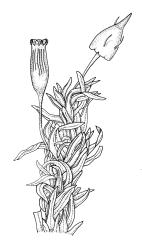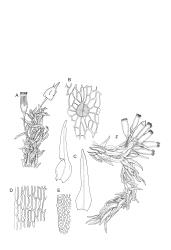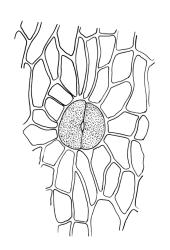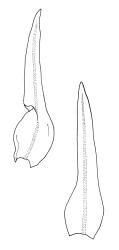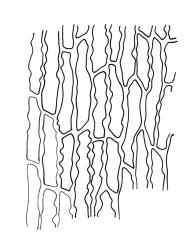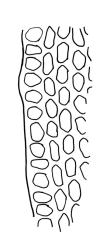Setae 4–7 mm, exposed for 1–4 mm beyond the perichaetial leaves (best seen when moist), usually 1(–3) per perichaetium; capsules cylindric-ovoid, long-exserted, mostly clearly ribbed (occasionally almost smooth) in upper half of urn when dry, 1.5–2.5 mm.
Lewinsky 1984, figs 3 (2), 4 (1), 13, 14; Lewinsky-Haapasaari & Ramsay 2006, fig. 26 g–n.
Orthotrichum tasmanicum var. tasmanicum is most likely to be confused with O. calvum, a species in which the leaves are crisped when dry and the capsules similarly exserted. However, O. calvum has generally shorter (c. 1.6–2.3 vs. 2.4–3.9 mm) and more strongly contorted dry leaves than O. tasmanicum var. tasmanicum. The immersed stomata, the narrow and mostly uniseriate endostome segments, and the naked calyptrae of O. calvum further distinguish it from the present taxon. The two taxa often grow intermixed.
Orthotrichum graphiomitrium has leaves less contorted when dry than O. tasmanicum var. tasmanicum, as well as ovoid, immersed capsules that are smooth and narrow-mouthed when dry with shorter, thinner-walled exothecial cells.
Confusion sometimes occurs with Ulota lutea. That species has more strongly contorted leaves when dry, a more defined oblong leaf base and several marginal rows of ± colourless cells with strongly thickened transverse walls at the leaf base. The stomata in U. lutea are restricted to the base of the capsule, rather than distributed in the middle or upper half of the urn as in O. tasmanicum var. tasmanicum.
NI: S Auckland, Gisborne, Hawke’s Bay, Taranaki, Wellington; SI: Nelson, Marlborough, Canterbury, Westland (Franz Josef, Lake Ianthe), Otago, Southland; St.
Australasian. Tasmania*, mainland Australia*.
Predominantly an epiphyte and growing on a wide range of indigenous and introduced shrubs and trees; rarely collected from non-calcareous rocks. Lewinsky (1984, tab. 1) recorded this variety from 19 genera of N.Z. native and 10 genera of introduced woody plants. It is frequently associated with Calyptopogon mnioides, Cryphaea spp., O. calvum and other species of Orthotrichum, Syntrichia papillosa, Tetraphidopsis pusilla, and Ulota lutea.
The variety tasmanicum is relatively rare in the driest parts of the South I. and there are no confirmed North I. records north of c. 38°S latitude. On the Mt Arthur Range (Nelson L.D.) it is an abundant taxon in the alpine and subalpine zones; there are many collections from low elevations throughout the Wairarapa region (Wellington L.D.). On the North I. ranging from sea level to at least 1360 m elevation (Kāweka Range, Hawke’s Bay L.D.) and on the South I. from near sea level (Hāpuku River, Marlborough L.D.) to at least 1650 m elevation (Mt Arthur Range, Nelson L.D.).



